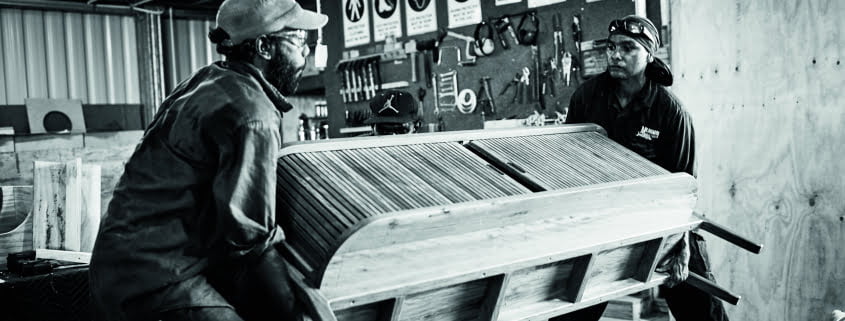Lightbulb moments can happen at any time and for Ramvek owner, Mark White, it was flying over Arnhem Land in the far north of Australia on his way to Europe with his wife, when he decided it was time to give back after a successful career in shopfitting for more than 30 years.
“There are a lot of things that can be done within Australia and especially when it comes to Indigenous people and unemployment,” White explains.
“I had a contact within the Arnhem Land Progress Aboriginal Corporation (ALPA), a non-for-profit Aboriginal-owned corporation which runs a number of community stores throughout Arnhem Land and I got involved with them in an advisory role.”
However, he wanted to do more and get his hands dirty so to speak and use his skills to create some employment in the area. When he put this to the ALPA board, which consists of all Aboriginal people, they liked the idea and so Manapan was born.
Manapan is located 500kms East of Darwin on Milingimbi Island in Arnhem Land, which is one of six islands that form an archipelago known as the Crocodile Islands.
It is a self-sufficient, self-funded enterprise owned and operated by the Yolngu people and backed by ALPA. It was launched to create industry and training pathways for the Yolngu people of Milingimbi Island and Arnhem Land and produce high-end furniture and office furnishings.
‘‘In my mind was a vision of beautiful, handmade Australian timber furniture, which could sit comfortably in the foyer of a corporate office or in the sitting room of a luxury apartment. I also wanted the furniture to incorporate Indigenous Australian art and showcase the local skills and beautiful materials found in Arnhem Land,” he says.
“We found this old shed in the middle of the island and refurbished it. We got some old machinery, etc. and set up a little workshop. Getting all our materials and machinery there was quite the challenge as we had to barge it all in and out.”
While the aim was to provide employment, because many in the community were reliant on social welfare and there was so much social pressure on people not to work, White says they had to work really hard to convince people this was a good thing.
“Today we have people working at Manapan who will stay back if needed because they love working there so much, which is fantastic, but it has taken many years to get to that stage.”
In the last couple of years, Aboriginal art and design has widely gained more traction with companies collaborating with various Indigenous artists to create unique ranges and at the same time create opportunities for the artists and their communities.
Manapan has established itself as one of the only Indigenous companies that produces high-end furniture for both private and corporate clientele. It has undertaken projects for the Australian Government, Australia Pacific Airports Melbourne, Royal Flying Doctor Service, Monash University, and one of the big four banks. Manapan’s next project is for Medibank, building a community table for each of Medibank’s stores throughout Australia.
For Manapan’s first collection, White travelled around Australia to meet with several architects and get them to design a piece of furniture that was going to be cutting edge but had an influence of Arnhem Land. They all jumped at the opportunity and he ended up with some great designs.
“This range of furniture just kicked it all off for us, everyone wanted it,” White enthuses. “We got the guys at the workshop involved and that’s how they learned their skills. A lot of them didn’t, for example, know how to measure things, so we had to really start with the basics.”
One of the people to teach them was Rob Crisfield, who has been with Manapan from the beginning of its journey, creating premium furniture pieces with his tightly-knit local Milingimbi crew.
“Under his guidance and using the talents of the best Australian designers and creatives, we believe we have the formula right. This furniture showcases the talents of some of our great Australian designers along with the skills of the Arnhem Land people.”
The timbers used to create the pieces are a mixture of locally sourced timbers that fell over during cyclone Lam in 2015, timber from Gumaj Aboriginal Corporation in Nhulunbuy and complemented with a mixture of sustainably harvested Australian timbers, creating unique pieces that are in high demand with appearances on the Block and a visit to the Milan furniture fair.
To keep the momentum going, the Manapan Academy was established to train people in the art of furniture making. This is not just for kids coming through the school and providing work experience but also people that have been unemployed for a long time.
Indeed, Manapan endeavours to empower local people with full-time employment. It is also building relationships between Indigenous and non-indigenous people by working together. It is the Yolngu people’s dream to see their children and grandchildren working here and gaining the skills and qualifications that will sustain their community for many future generations.
“My main reason for starting Manapan was to create employment, for young and old, and we’ve accomplished that and at the same time we have been able to create some beautiful furniture and get the word out about Aboriginal art and the stories behind it.
“But during this process we learned a lot of things too. They provided some beautiful carvings and the stories behind a lot of the furniture, so it really developed all from there.”
For White, now is the time to take a step back after 10 years with Manapan. While he will still be involved, he needed to get the business to a point where it could run by itself with the backing of ALPA and the guys at the workshop doing things on their own.
“The only way this was going to work was it had to be done in a commercial way. We build a bit of furniture, we make some money, we make enough and we buy another machine. This is a really important way to run the business if we want to be around for a while. We have been around for 10 years, we want to be around for many more years.”
Manapan is a 100 per cent Aboriginal-owned enterprise with all surpluses invested back into Indigenous communities and is proud of the fact it is not reliant on government money. In fact, when a government agency asks ‘how much money the business wants’, White always replies with ‘we don’t want your money, just give us some orders’.
“A lot of companies come into these places with a heap of money and when the money runs out the business goes. We don’t want to do that. We now have the community support as well, because they know we are here for the long run.”
So where does White see Manapan in 10 years? “I’d like to think by then we are self-sufficient. I’d like to think that the kids from the original teams are working there, I’d like to think we have some Indigenous designers doing their own stuff. And I’d like to think that what we have created can be replicated in other Aboriginal communities.
“It will take some time and effort but it is very fulfilling and it is a great way to create employment and a purpose for everyone.”

